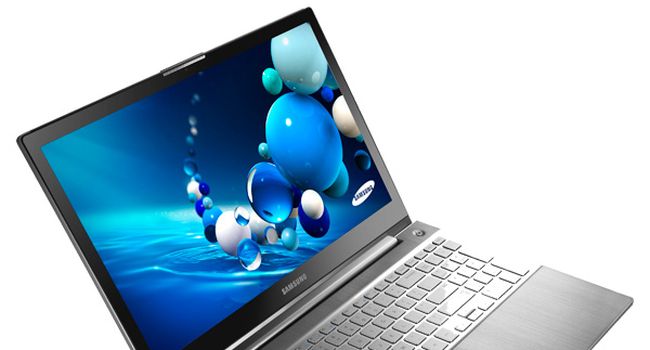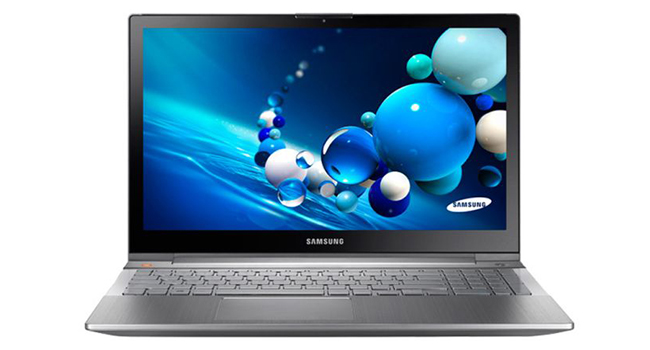LG’s 100-Inch QNED evo AI TV Redefines Big-Screen Viewing in South Africa In a bold leap forward for home entertainment, LG Electronics South Africa…
Samsung ATIV Book 8 review: a costly, underwhelming laptop


I think Samsung is playing a joke on me. Its US$1269 notebook, the Samsung ATIV Book 8 feels like a half-baked idea: one part Ultrabook and one part netbook. This recipe creates a bitterly disappointingly weak laptop that barely lives up to the exceptionally generous specifications which seem to have no effect on the performance of the Book 8. Samsung made a rather expensive turkey that looks tender and crisp on the surface, but when sliced into, deflates like an old balloon.
The Setup
The Book 8 is a Windows 8 (I updated it to Windows 8.1) laptop running a Core i7 2.4Ghz CPU alongside 8GB RAM and a 1TB 5400 RPM drive. To justify its price, the Book 8 has a dual GPU setup: the bog-standard Intel HD and the impressive AMD Radeon HD 8770M GPU. With specifications like these, it’s hard not to be initially impressed based on these names alone. But the Book 8 messes it all up by being an all-round disappointment in mostly every aspect, with the exception of video and audio content.
Samsung, like with its phones, crams as much power as it can into the Book 8 but is seemingly unable to harness it to any great effect. At least with its phones, expectations are significantly lower. No one expects a phone to run Far Cry 3, or to open a Word document instantly. Or to boot in nine seconds or less. I expected all of this from the Book 8, but instead was served a steaming plate of disappointment. Let’s concentrate on the good first. Even non-sentient life deserves a fair chance.
The good
I like the Book 8 because of these reasons: the Full HD 15.4″ display, the JBL 4W stereo speakers, the backlit chiclet keys and the crazy-long battery life. Samsung excels in these areas because hell, it’s Samsung and interface, display and battery power is what it’s best at. Samsung chose a matte screen so there’s no glare which produces a fine display, so fine that full HD content looks as lifelike as possible. The display even tends to add a liquid quality to everything in motion, provided that the weak hard drive doesn’t stutter and freeze the Book 8 as it’s loathe to do. Outside of the MacPro with Retina Display, the Book 8’s display is without equal. Samsung did its homework and Windows 8.1 is the perfect fit for the 1920×1080 screen. You’ll be genuinely surprised at the difference a full HD display makes. I had a weird issue with Chrome though, in that the browser made every site look like it had been smeared in Vaseline. I had to manually adjust the size of the system fonts to correct this, but it wasn’t a step that a beginner would suss out, so shame on you Samsung. For this type of money, I expect my purchase to run optimally out of the box.
The sound also surprised me. Usually, I’ll pair my gadgets with a Bluetooth speaker to negate the dreadful audio that portable devices are want to produce. The Book 8 flies in the face of defiance with crisp sound that while lacking in bass, is rich and tuneful. JBL it seems, knows how to create portable audio output. Not once did I miss the sound of my Sony speaker while using the Book 8, so kudos to Samsung for getting this spot on.
It was the battery life that surprised me the most. The 6050mAh, 8-cell Li-Po battery delivers five hours of multimedia use, and eight hours plus when it comes to basic computing. Samsung has optimised the Book 8 beautifully and the machine runs its power consumption needs like a well orchestrated symphony. Just a note: instantly switch the battery performance options (left-click on the battery icon on the taskbar) and change it from “Samsung Optimised” to “High Performance”. You’ll notice almost an 2X performance improvement across every area of the PC. This is a laptop you can safely charge at night and then take to work sans power supply. If you’re light on YouTube and stick to web browsing, the Book 8 will last for an entire working day.
Let’s wrap-up with the chiclet keys that are large, responsive and perfectly paced. I’m a writer and the Book 8 didn’t slow me down once. My fingers flew across the keyboard, hungry for input and rarely missing a letter as I spun articles from concept to life. This is how a laptop keyboard should be and again, Samsung is commended for it.
Everything falls apart when you try to go above the scope of the Book 8. But because it’s such a powerful machine (at least on paper), the Book 8 wants to be pushed, but unfortunately it pushes back with the sort of disdain usually reserved for Zune owners.
I also adore the touchpad. It’s not often that a company can create a product that’s on par with Apple hardware, but the Book 8 succeeds. The larger-than-life touchpad is highly sensitive to both touch and pressure, so using it over an actual USB mouse is for once, not an issue. I even found that in some cases (Windows 8.1 shortcuts), using the two-finger swipe gestures was preferable over a mouse. Samsung did its homework well with this piece of kit.
Samsung also provides us with a host of ports and the Book 8 could be the most option-filled laptop I’ve yet reviewed. On the left-hand side there’s a network cable port (which folds up to retain the sleek shape of the Book 8), VGA, HDMI, a 3.5mm sound port and two USB 3.0 slots. On the right is a security lock, two USB 2.0 ports and an SD card slot. What’s missing? An optical drive but welcome to 2013, where optical drives no longer matter.
Here’s where it all falls down
Ask yourself, what do you need the Book 8 for? For close to US$1300, Samsung isn’t aiming the Book 8 at the budget-conscious crowd. This is a laptop for the power user, the type of person who scoffs in the face of 4GB RAM and says, “give me more!” without realising what more really is. Every issue I have with the Book 8 stems from its inability to perform at a level that both the price and specifications fail to live up to.
So what do you need this laptop for? If you say “business” I can list ten other laptops for half or a third of the price that work just as well, if not better. If you say “gaming” then you’re in a for a rough ride, as the 1TB 5400 RPM drive is anything but fast. It’s embarrassingly slow matter of fact. Why Samsung couldn’t have bunged a 256GB solid-state drive into the Book 8 for the same price is beyond me. The hard drive’s activity light is constantly blinking, and that’s even when I’m writing or checking my email. These are activities that barely scratch the performance of my iPhone, so why is a fully fledged laptop giving me such guff? I take no joy from knocking such an aesthetically pleasing machine, but at this price, it makes my blood boil. I only had to perform one hard drive test and that was a dual-boot. One machine was a Centrino CPU netbook with a 256GB SSD, the other was the Book 8. Both ran Windows 8.1 but only one booted in four seconds or less. It wasn’t Samsung’s laptop. It was the three-year old netbook. I’m positive that if I swapped out the hard drive for a solid state variant my speed would double, but I received the Book 8 as is, so why should I have to mod a laptop that already costs a fortune?
It was the gaming side that let me down the most, and was a bitter pill to swallow. A true gaming laptop (MacPros, Alienware, mostly anything by MSI) can cost the same but won’t disappoint like the Book 8 has. I won’t bore you with benchmarks, just the languid experience of the syrupy graphics engine. I tested four games: Far Cry 3, Assassins Creed 3, The latest Splinter Cell and LEGO: Marvel Super Hero. The game that ran the best was LEGO, but despite being a graphically pleasing game, is not hardware intensive. Games that should have run well, but didn’t include every other game I tested. Far Cry 3 at medium – which looks almost as good as the Xbox 360 version – had horrendous screen-tearing. After I turned V-sync on to eliminate this, the frame rate dropped to the low 20’s. I had the same experience with Splinter Cell and AC3.
To add insult to injury, the hard drive crawled, and couldn’t even keep up with the pace of some games. Loading times took an age, and woe betide those who alt-tab out of the game. For an 8GB machine, it seems wrong to have to hard-reset after every gaming session. RAM is gobbled up in seconds, and won’t refresh until the Book 8 reboots. Even though the Book 8 is priced as a gaming laptop, it’s not meant for gamers. The Book 8’s hardware succumbs to casual games like Plants versus Zombies and rich 2D titles such as Super Meat Boy. When 3D is thrown at its way, it’s anything but an epic gaming machine. With these specs, it should be.
As for the design, the Book 8 is 2.6KG but feels far lighter than this thanks to its aluminium frame. It’s an exceptionally classy laptop, but veers towards a business-like sensibilities screaming “I’m a corporate machine, look at my classic lines and metallic shine. LOOK AT ME!” but it’s a fingerprint magnet and after a few hours of use, the Book 8 looks browbeaten, for lack of a better work.
Verdict:
Samsung’s ATIV Book 8 is almost double the price it should be. For US$1269, I want speed, power, excellent battery life and good looks. Two out of four ain’t going to cut it for me. And it won’t for you either.
+Great battery life
+Excellent display
+Strong sound
+Brilliant keyboard and touchpad
+Classy looks-weak GPU
-dirt slow 1TB hard drive
-overheats on the hinge
-too expensiveScore: 5/10


